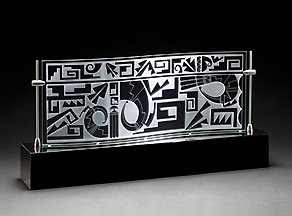Well, that kind of freezing of art styles exactly what certain "enlightened" Anglos tried to force upon the artists of the Pueblos. Beginning in the late-1800's, a powerful Anglo movement arose which had the goal of "saving" Pueblo art. In their infinite wisdom, these fine folks missed the point that all art evolves over time, and that the Pueblo pottery styles of the late-1800's (as well as Pueblo weaving, painting, and sculpture) were substantially changed from the pre-Spanish period of pre-1540. After 350 years of occupation by the first the Spanish, then the Mexicans, and the Americans beginning in 1848, the art of the Pueblos had already undergone massive revisions and evolutionary changes. New forms were adopted, new imagery appeared (such as Moorish fretwork designs imported from Spain), and firing techniques on pottery oftentimes were adapted to more modern methods.
Despite all of the aforementioned changes, the Anglos that controlled the administration of the Pueblos attempted to force continued adherence to techniques of the 1880's well into the 1980's. For a long period, this attempt to keep native artists severely constrained in what they could do worked. When the first Indian Markets were held during the 1920's, it was even still forbidden for the Native American artists to sign their works, as that was considered too non-traditional. Slowly over time, however, these barriers gradually broke down, as Indian artists staged a quiet revolt against being forced to create art completely by Anglo definitions. To many conservatives (Anglo and Indian, alike) these changes are heretical, as the use of purchased clay, kilns, oil paints, and commercial wools and fabrics are still frowned upon. Even in just the 10 years that I have been attending Indian market, however, I have seen a steady trend toward more vibrant and engaging Indian art. As tribal members, such as Diego Romero and his brother Mateo, return to the Pueblos with formal art training, they bring entirely new perspectives and techniques. It would have been inconceivable, for example, for traditional Santa Clara pottery motifs to have been merged with Northwest Coast motifs years ago, and then cast in stunning editions made of metal and glass. Tammy Garcia managed to pull that off, however, and her works can now bring upwards of $60,000 each. In the meantime, her sisters, who follow more traditional Santa Clara pottery methods, are lucky if they can sell their bowls for $500.
For more of Rozanski's musings on Indian subjects, see NMAI = Piece of Junk and The Pottery-Comics Connection.
Below: "Sikyatki Birds by Tammy Garcia--glass sculpture sand-carved glass on granite base."


No comments:
Post a Comment
Note: Only a member of this blog may post a comment.